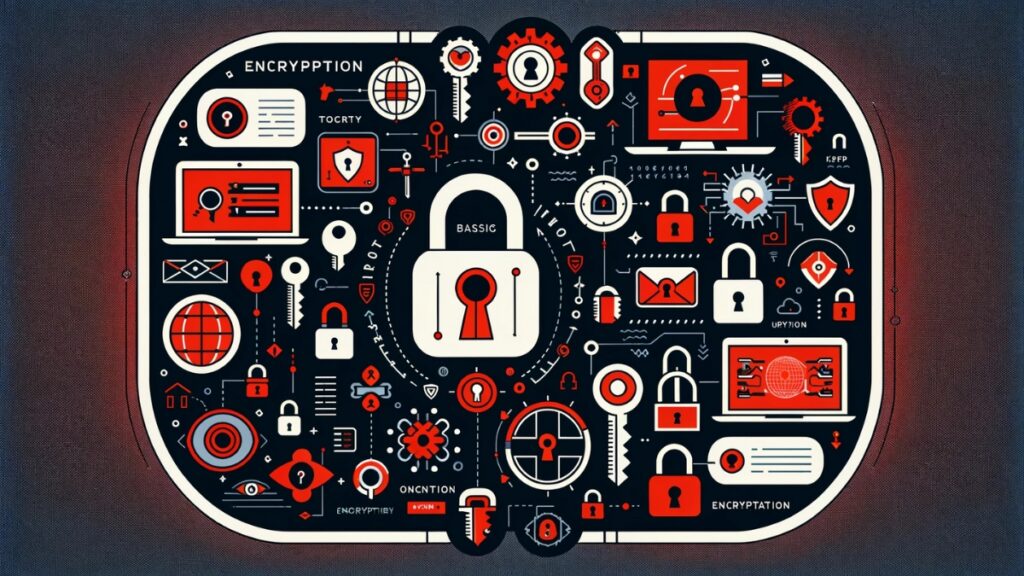Data encryption is a critical component in safeguarding digital information. From personal data protection to securing sensitive corporate information, encryption plays a pivotal role in cybersecurity. This guide delves into the various techniques and tools of data encryption, providing a comprehensive understanding suitable for both novices and seasoned tech enthusiasts.
Understanding Data Encryption
Definition and Basics of Data Encryption
Data encryption is the process of converting information or data into a code, especially to prevent unauthorized access. This section will explain the fundamental concepts of encryption, including key terms and how encryption works to protect data.
Types of Encryption: Symmetric vs. Asymmetric
- Symmetric Encryption: Involves a single key for both encryption and decryption. Examples include AES (Advanced Encryption Standard) and DES (Data Encryption Standard).
- Asymmetric Encryption: Uses a pair of keys – a public key and a private key. RSA (Rivest–Shamir–Adleman) is a widely used asymmetric algorithm.
Common Encryption Algorithms
- AES (Advanced Encryption Standard): Widely used for securing sensitive data, particularly by the U.S. government.
- RSA (Rivest–Shamir–Adleman): A cornerstone of modern internet security, commonly used in digital certificates and SSL/TLS encryption.
- Other Algorithms: Discussion of additional algorithms like Blowfish, Twofish, and ECC (Elliptic Curve Cryptography).
Implementing Encryption Techniques
Step-by-Step Guide on Basic Encryption Implementation
This section provides a practical guide to implementing basic encryption using Python, focusing on AES (Advanced Encryption Standard), a widely used symmetric encryption algorithm.
Step 1: Setting Up Your Environment
- Ensure you have Python installed on your system.
- Install the
pycryptodomelibrary, which provides cryptographic functions including AES. You can do this by runningpip install pycryptodomein your terminal.
Step 2: Import Necessary Modules
- Start your Python script by importing the necessary modules:
from Crypto.Cipher import AES
from Crypto.Random import get_random_bytes
Step 3: Generating a Key
- AES requires a fixed-size key (128, 192, or 256 bits). For this example, we’ll use a 256-bit key.
key = get_random_bytes(32) # 32 bytes * 8 = 256 bits
Step 4: Preparing Your Data for Encryption
- AES operates on fixed-size blocks of data. Ensure your data is a multiple of the block size (16 bytes for AES). Padding can be used for data that doesn’t fit perfectly.
def pad(data):
return data + b"\0" * (AES.block_size - len(data) % AES.block_size)
data = "Your secret message".encode()
padded_data = pad(data)
Step 5: Encrypting Data
- Initialize the AES cipher with your key and select a mode (e.g., CBC – Cipher Block Chaining).
- Encrypt the data using the initialized cipher.
cipher = AES.new(key, AES.MODE_CBC)
ciphertext = cipher.encrypt(padded_data)
Step 6: Saving the Encrypted Data
- Store the encrypted data. Remember to also save the key and the IV (Initialization Vector) if you’re using a mode like CBC.
with open('encrypted_data.bin', 'wb') as f:
f.write(cipher.iv)
f.write(ciphertext)
Step 7: Decrypting Data
- To decrypt, initialize a new AES cipher with the same key and IV, then decrypt the ciphertext.
def decrypt(ciphertext, key):
iv = ciphertext[:16] # extract the IV from the start
cipher = AES.new(key, AES.MODE_CBC, iv)
plaintext = cipher.decrypt(ciphertext[16:])
return plaintext.rstrip(b"\0") # remove padding
with open('encrypted_data.bin', 'rb') as f:
encrypted_data = f.read()
decrypted_data = decrypt(encrypted_data, key)
print(decrypted_data.decode())
Use Cases for Different Encryption Types
- Symmetric Encryption (like AES): Ideal for encrypting large volumes of data due to its efficiency and speed. Commonly used in securing file storage, database encryption, and secure communications within a trusted environment.
- Asymmetric Encryption (like RSA): Primarily used for secure key exchanges, digital signatures, and encrypting small amounts of data. It’s vital in scenarios like email encryption, SSL/TLS for websites, and authenticating software updates.
Best Practices for Encryption
- Regularly Update Encryption Algorithms: Stay informed about the latest developments in cryptographic standards and update algorithms accordingly.
- Secure Key Management: Protect encryption keys with stringent security measures. Consider using hardware security modules (HSMs) for storing keys.
- Encryption Strength and Key Length: Understand that the strength of encryption is tied to key length. Longer keys generally provide stronger encryption but may impact performance.
Encryption Tools Overview

Overview of Popular Encryption Tools
In this section, we will explore a variety of encryption tools, ranging from software solutions for end-users to enterprise-level hardware encryption devices. Understanding the features and benefits of each will help you select the right tool for your specific needs.
Software Encryption Tools
- BitLocker: A full disk encryption feature included with Windows. It uses AES encryption and is ideal for securing data on hard drives, especially in lost or stolen devices.
- VeraCrypt: An open-source disk encryption tool for Windows, macOS, and Linux. VeraCrypt enhances the security of the algorithms used for system and partitions encryption, making it immune to new developments in brute-force attacks.
- GnuPG (GPG): A free implementation of the OpenPGP standard, allowing you to encrypt and sign your data and communications. GPG is widely used for secure email communications.
Hardware Encryption Tools
- Hardware Security Modules (HSMs): Physical devices that provide secure key management and cryptographic operations. Commonly used in enterprise environments for managing keys used in SSL/TLS and database encryption.
- Self-Encrypting Drives (SEDs): Hard drives with built-in encryption hardware. SEDs are fast and transparent to the user, providing encryption at the hardware level, which is generally more secure and less prone to software-based attacks.
Mobile Encryption Apps
- Signal: A messaging app known for its end-to-end encryption, providing secure messaging and calling. Signal’s protocol is considered the gold standard in mobile encryption.
- ProtonMail: An email service offering end-to-end encryption, ensuring that emails are only readable by the sender and the recipient.
Features and Benefits of Each Tool
Each encryption tool offers unique features and benefits, making them suitable for different scenarios:
- BitLocker: Integrated with Windows, providing a seamless encryption experience for Windows users. It’s particularly beneficial for protecting data on laptops and other portable devices.
- VeraCrypt: Offers advanced encryption options, like hidden volumes and dual-boot encryption, making it a versatile choice for users needing additional security layers.
- GnuPG (GPG): Ideal for encrypting emails and files, particularly in scenarios where secure communication is paramount.
- Hardware Security Modules (HSMs): Provide robust security for key management, making them indispensable in high-security environments.
- Self-Encrypting Drives (SEDs): Offer automatic encryption at the hardware level, making them an excellent choice for protecting sensitive data without affecting system performance.
- Signal: Known for its simplicity and strong encryption, Signal is an excellent choice for private conversations.
- ProtonMail: Provides a secure and private email solution, with the convenience of being accessible from any web browser.
Comparison of Tools Based on Use Cases
When selecting an encryption tool, consider your specific use case:
- For individual users needing to encrypt files or disk partitions, VeraCrypt is a robust and versatile choice.
- For organizations requiring secure key management and cryptographic operations, HSMs are the go-to solution.
- For mobile users seeking secure communication, Signal and ProtonMail offer reliable end-to-end encryption for messages and emails.
Advanced Encryption Techniques
Explanation of Advanced Techniques
This section delves into more sophisticated encryption techniques that offer enhanced security and specific functionalities suited for complex scenarios.
End-to-End Encryption (E2EE)
- Definition: A method of secure communication that prevents third-parties from accessing data while it’s transferred from one end system to another.
- Implementation: Commonly used in messaging apps like WhatsApp and Signal. In E2EE, data is encrypted on the sender’s device and only decrypted on the recipient’s device.
- Advantages: Ensures that intermediaries, such as servers or ISPs, cannot access the plaintext data.
Homomorphic Encryption
- Definition: Allows computation on ciphertexts, generating an encrypted result which, when decrypted, matches the result of operations performed on the plaintext.
- Implementation: Useful in cloud computing, where it allows users to securely outsource storage and computation. For instance, a cloud service can perform computations on encrypted data without ever having access to the unencrypted data.
- Challenges: Currently, it’s computationally intensive and not yet practical for all applications.
Quantum Cryptography

- Definition: Uses principles of quantum mechanics to secure data. Quantum Key Distribution (QKD) is a well-known application.
- Future Prospects: Quantum cryptography promises to be unbreakable by any computational means but is still in the experimental stage. It’s poised to become more relevant with the advancement of quantum computing.
Use Cases for Advanced Techniques
- End-to-End Encryption: Best suited for private communications, such as secure messaging and email services.
- Homomorphic Encryption: Ideal for privacy-preserving computations in cloud computing, allowing data analysis without exposing the raw data.
- Quantum Cryptography: Has potential for ultra-secure communication channels, particularly in governmental and military communications.
Keeping Up with Advancements
- Research and Development: Following the latest research in cryptography can provide insights into these advanced techniques and their practical applications.
- Industry Impact: As these technologies evolve, they will significantly impact various industries, necessitating a continuous update of encryption strategies.
Encryption in Various Platforms
Encryption in Windows, macOS, Linux
Windows
- Built-in Tools: BitLocker provides full disk encryption for Windows users. It’s easy to set up and is integrated into the operating system, ensuring seamless encryption for users.
- Third-Party Tools: Software like VeraCrypt can also be used for additional encryption needs, like encrypting individual files or external drives.
macOS
- Built-in Tools: FileVault is macOS’s native encryption solution, offering full disk encryption using XTS-AES-128 encryption with a 256-bit key. It helps in preventing unauthorized access to information on the startup disk.
- Third-Party Tools: Users can also opt for tools like VeraCrypt for more customizable encryption solutions.
Linux
- Built-in Tools: Most Linux distributions come with LUKS (Linux Unified Key Setup) for disk encryption. LUKS is a standard for Linux hard disk encryption.
- Third-Party Tools: Tools like GnuPG can be used for encrypting files and emails, and VeraCrypt for creating encrypted volumes.
Mobile Encryption (Android, iOS)
Android
- Built-in Encryption: Since Android 6.0 (Marshmallow), devices are encrypted by default, using AES encryption. This includes a unique key that is stored in the device’s Trusted Execution Environment.
- App-Based Encryption: Apps like Signal and WhatsApp use end-to-end encryption to secure messages and calls.
iOS
- Built-in Encryption: iOS devices use hardware encryption. Data protection with a passcode uses a combination of a device-specific key and the user’s passcode to create a unique key for encrypting and decrypting data.
- App-Based Encryption: Similar to Android, iOS supports end-to-end encryption in apps like Signal and WhatsApp.
Cloud Encryption (AWS, Azure, Google Cloud)
AWS (Amazon Web Services)
- Key Management Service (KMS): AWS KMS allows you to create and manage cryptographic keys and control their use across a wide range of AWS services and applications.
- Encryption Solutions: AWS provides encryption for data at rest and in transit, offering services like Amazon S3 for storage encryption.
Azure
- Azure Key Vault: Helps in safeguarding cryptographic keys and other secrets used by cloud apps and services.
- Data Encryption: Azure provides transparent data encryption for SQL and Azure Blob storage encryption.
Google Cloud
- Cloud Key Management: Google Cloud offers a robust key management system, integrating with their cloud services for secure encryption key storage and management.
- Data Encryption: Google Cloud automatically encrypts all data before it’s written to disk. There’s also an option for customer-managed encryption keys for more control.
Legal and Ethical Considerations

Legal Aspects of Encryption
Compliance with Data Protection Laws
- Global Regulations: Understanding and complying with various data protection laws like GDPR (Europe), CCPA (California), and others is crucial. These laws often mandate specific encryption standards to protect personal data.
- Industry-Specific Regulations: Certain industries, like healthcare and finance, have additional regulations (like HIPAA and PCI-DSS) that include encryption requirements.
Government Regulations and Backdoors
- Encryption Backdoors: Some governments have proposed or enacted laws that require backdoors into encryption for law enforcement purposes. This is a contentious issue, as it could potentially weaken overall security.
- International Considerations: Encryption regulations can vary significantly by country. In some jurisdictions, encryption is highly regulated or even restricted.
Ethical Implications and Responsibilities
Privacy vs. Security
- Balancing Act: There’s often a debate between the need for privacy (protecting user data through encryption) and the need for security (law enforcement’s need to access data in criminal investigations). Ethical considerations revolve around finding the right balance.
- User Trust: Companies and developers must handle user data responsibly, maintaining trust by using encryption effectively to protect privacy.
The Dual-Use Nature of Encryption
- Beneficial Uses: Encryption is crucial for protecting sensitive data, ensuring secure communications, and safeguarding personal privacy.
- Malicious Uses: Conversely, encryption can be used by malicious actors to conceal illicit activities. This raises ethical questions about the extent to which encryption should be made available and to whom.
Transparency and Disclosure
- Openness with Users: It’s important to be transparent about how, when, and why encryption is used. Clear communication about data handling practices builds trust and helps users make informed decisions.
- Handling Vulnerabilities: Ethically, if vulnerabilities in encryption algorithms or implementations are discovered, there should be a transparent process for addressing and disclosing these issues.
Conclusion
In this comprehensive guide, we’ve traversed the multifaceted landscape of data encryption, covering its essential techniques, tools, and advanced methodologies across various platforms. From the fundamental principles to the cutting-edge advancements, our journey underscored the critical role encryption plays in safeguarding digital information. By delving into both popular and sophisticated encryption tools, we’ve seen how they cater to a myriad of needs, from individual privacy concerns to complex organizational security demands. The exploration of legal and ethical considerations further illuminated the intricate balance between privacy, security, and regulatory compliance, highlighting the pivotal role of responsible encryption practices.
As the digital world continues to evolve, the importance of encryption in protecting data cannot be overstated. Whether you’re a tech enthusiast, a cybersecurity professional, or just beginning to navigate the world of digital security, understanding and implementing encryption is paramount. This guide serves not just as an educational resource, but also as a call to action for proactive engagement with encryption technologies. By staying informed and adaptable to the ever-changing digital landscape, we can ensure the security of our data and the integrity of our digital interactions, today and into the future.
References
To further enhance your understanding and knowledge of data encryption, the following resources are highly recommended. They offer in-depth insights and detailed information on various aspects of encryption technology.
- “Cryptography and Network Security: Principles and Practice” by William Stallings: A comprehensive textbook providing a thorough overview of cryptographic and network security principles.
- “Applied Cryptography: Protocols, Algorithms, and Source Code in C” by Bruce Schneier: A seminal book in the field of cryptography, offering detailed insights into cryptographic algorithms and how to implement them.
- National Institute of Standards and Technology (NIST) Publications: NIST provides a wealth of resources, including detailed standards and guidelines on encryption algorithms and practices (https://www.nist.gov/).
- “The Code Book: The Science of Secrecy from Ancient Egypt to Quantum Cryptography” by Simon Singh: A fascinating read on the history and evolution of encryption.
- Electronic Frontier Foundation (EFF) Resources on Encryption: EFF offers various resources discussing the legal and ethical aspects of encryption (https://www.eff.org/).
- “Introduction to Modern Cryptography” by Jonathan Katz and Yehuda Lindell: This book focuses on the theoretical aspects of cryptography and is ideal for those who want a deeper understanding of the underlying principles.
- IETF RFCs (Request for Comments): The Internet Engineering Task Force publishes RFCs that include many standards and proposals for cryptographic protocols and methods (https://www.ietf.org/rfc.html).
- Open Web Application Security Project (OWASP) Cryptography Resources: OWASP provides practical advice and resources on implementing cryptography securely in software applications (https://owasp.org/).
- “SSL and TLS: Theory and Practice” by Rolf Oppliger: This book provides a detailed understanding of SSL/TLS protocols, crucial for securing internet communications.
- Schneier on Security Blog: Bruce Schneier’s blog offers up-to-date commentary and analysis on contemporary security issues (https://www.schneier.com/).
These resources provide a solid foundation for both beginners and experienced practitioners in the field of encryption, offering a blend of theoretical knowledge, practical guidance, and insights into the latest trends and developments.




